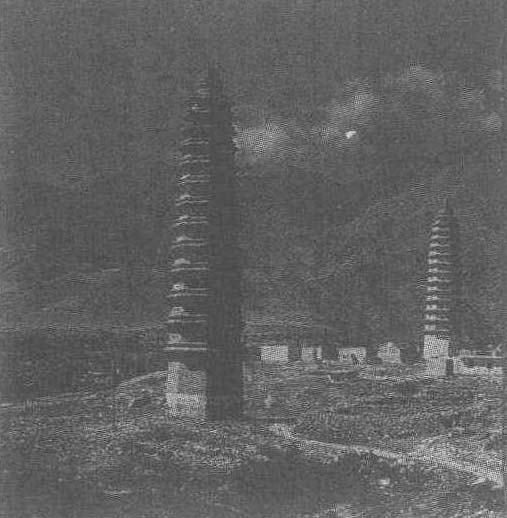拜寺口双塔
佛教砖塔。位于今宁夏银川市西北45公里贺兰山拜寺口内。两塔东西向排列,间距约100米。塔体八角。东塔13层,密檐式,通高约45米。除第一层较高外,第二层以上各层檐之间高度骤减; 第十三层之上置仰莲瓣形刹座,上承托相轮。檐下每面装有两个砖雕兽面。塔室为圆形,向南一面辟有券门。塔内原有木梯通顶。西塔14层,除第一层外,其余各层塔檐下每面正中有一浅龛,内塑一佛像,或坐或立,千姿百态。每层塔棱转折处,又塑佛像一尊。
拜寺口双塔
位于宁夏回族自治区银川市西北45公里的贺兰山拜寺口内。两塔东西相距百余米,是宁夏仅有的密檐式塔。东面一塔高约45米,砖筑八角13层,第一层塔身较高,二层以上檐与檐之间塔身逐渐缩短,每层塔檐下各面均有两个砖雕兽头,怒目圆睁,形象凶猛威严。塔身南侧开一门,塔室为圆形,原有木梯可攀登。西面一塔形制与东塔类似,共14层,二层以上的每层塔檐下每面正中砌一个浅壁龛,内有一尊泥塑佛像,各具情态。龛左右的砖雕兽头口含串珠。塔身每面转折处又雕佛像一尊。拜寺口双塔的始建年代未见记载,专家推测可能建于西夏。双塔为全国重点文物保护单位。

拜寺口双塔
拜寺口是贺兰山山口之一,位于银川市西北45公里,在贺兰山县金山乡境内。两座古塔屹立在山口北边台地上。
两塔东西相对,相距约100米。它们有很多相同之处。东面一塔,从底层到顶层收分不大,塔身外观呈直线锥体,显得挺拔有力。砖筑八角13层,高约45米。塔身作密檐式,除第一层比较高以外,第二层以上檐与檐之间的高度骤然缩短,第13层之上,置上仰莲瓣形刹座,上承托相轮。檐下每面并列两砖雕兽面,十分威猛。西面一塔,比东塔粗壮高大,塔身上部数层收分较大,砖筑14层,外形和高度与东塔相似,除第一层外,其余各塔身檐下每面正中有一浅龛,龛内塑一佛像,或坐或站,千姿百态,造型各异。龛的左右饰以兽头, 口含串珠。每层塔棱转折处,又塑有佛像一尊,使塔的壁面充满神秘的色彩。
塔下台地为西夏遗址,曾有与西夏陵园相同的绿色琉璃瓦出土。明《嘉靖宁夏新志》载,这里是西夏开国皇帝李元昊的“避暑宫”,当时“遗址尚存,人于朽木中尝有拾铁钉长一二尺者”。清乾隆三年,宁夏发生强烈地震,并未将这二塔震倒。这两座古塔的建筑年代虽有待考证,但很可能是西夏遗留下来的建筑。
1988年1月,拜寺口双塔被国务院列为第三批全国重点文物保护单位。
拜寺口双塔
全国重点文物保护单位。位于市西北45公里,贺兰山拜寺口北岗上,为宁夏境内仅存的密檐式砖塔。双塔是古代佛教建筑,始建于西夏后期,西塔早于东塔。元代曾重加修饰彩绘。两塔东西相对,相距近百米。东塔,砖筑八角十三层,外观秀拔,残高39.15米,底层每边长2.93米,无基座,底层塔身素面,正南辟有券拱门,可通塔室。除第一层较高外,第2层以上檐与檐之间的高度逐层加密,每层各面影塑2个彩绘兽面,兽面间影塑日、月、云、火焰宝珠图案,第13层之上,置上仰莲瓣形刹座,承托相轮。塔室圆形,系厚壁空心式木板楼层结构,原有木梯可供攀登。西塔也是13层,较东塔粗壮,外形呈抛物线状,残高41米,底层边长3.1米。自二层以上,塔身每面正中有一浅龛,龛内塑佛像一尊。龛的左右上角塔身转折处,又各雕佛像一尊。西塔刹座穹室内发现梵文题记11条,西夏文题记6条,以及彩胶漆绢佛画、元代中统交钞、银币、喜吉金刚像等。1986年对双塔进行了加固修复。两塔间原有佛寺,已圮,遗址上发现与西夏陵园相似的绿色琉璃瓦,寺始建年代当与此相近。
- goatsueker
- Goa,Daman and Diu
- Gobbi,Tito
- Gobelines,Manufacture nationale des
- Gobi Desert
- Gobind Singh
- Gobineau,Joseph Arthur,Comte de
- goblin shark
- goby
- God
- Godalming
- Godard,Jean-Luc
- Godavari,River
- Goddard,Robert Hutchings
- Godden,Rumer
- Godel,Kurt
- Goderich,George Frederick Samuel Robinson,Viscount
- Godesberg
- Godey,Louis Antoine
- Godfrey of Bouillo
- Godiva,Lady
- Godolphin,Sidney,Earl of
- Godoy,Manuel de
- God Save the King
- Godthab